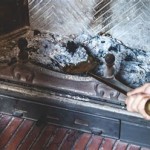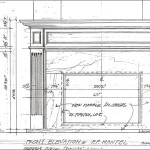Wooden Fireplace Mantel Designs: A Comprehensive Guide
A fireplace mantel serves as a focal point within a living space, providing a visual anchor and an opportunity to express personal style. Among the various materials available for mantel construction, wood remains a consistently popular choice due to its inherent warmth, versatility, and aesthetic appeal. Wooden fireplace mantels can be customized to complement a wide range of architectural styles, from rustic to modern, making them a desirable addition to homes of diverse designs. This article explores various wooden fireplace mantel designs, examining the factors that influence their selection and integration within a room.
Understanding the Appeal of Wooden Mantels
The enduring popularity of wooden mantels stems from a combination of practical and aesthetic considerations. Wood offers a natural beauty that is difficult to replicate with synthetic materials. Its grain patterns, color variations, and textures contribute to a sense of authenticity and warmth. Furthermore, wood is a relatively easy material to work with, allowing for intricate carvings, custom shapes, and personalized finishes. Its structural integrity also ensures that a wooden mantel can support decorative objects, artwork, and other accessories. Unlike some more contemporary materials, wood also ages gracefully. While minor wear and tear can occur, these imperfections can often add to its character and charm. Finally, wood is a sustainable material when sourced responsibly, contributing to environmentally conscious design choices.
The selection of wood species significantly impacts the overall look and feel of the mantel. Hardwoods, such as oak, maple, cherry, and walnut, are known for their durability and rich color variations. Oak, with its prominent grain, is often used for rustic and traditional designs. Maple, with its smooth texture and light color, lends itself well to contemporary or minimalist styles. Cherry offers a warm reddish hue that adds elegance and sophistication to any space. Walnut, with its dark and complex grain, provides a luxurious and visually striking option. Softwoods, such as pine and cedar, are generally less expensive and easier to work with, making them suitable for painted or distressed finishes. Pine’s knotty character is well suited for cottage or farmhouse style interiors. Cedar offers excellent resistance to decay and insects, making it a good choice for mantels near potentially damp conditions.
Beyond the choice of wood species, the finish applied to the mantel also plays a crucial role in defining its aesthetic. A clear finish allows the natural beauty of the wood to shine through, highlighting its grain patterns and color variations. Stains can be used to enhance or alter the wood's color, creating a darker, richer tone or a lighter, more weathered appearance. Paint offers a versatile option for customization, allowing the mantel to be coordinated with the room's color scheme. Distressed finishes, involving techniques such as sanding, chipping, or antiquing, can create a vintage or rustic charm. Finally, the texture of the finish, whether smooth and polished or rough and tactile, contributes to the overall sensory experience of the mantel.
Exploring Different Wooden Mantel Styles
Wooden fireplace mantels are available in a wide variety of styles, each characterized by its unique design elements and historical influences. Choosing the right style can significantly enhance the overall aesthetic of the room and create a cohesive design scheme.
Traditional Mantels: Traditional mantels are often characterized by their ornate details, symmetrical designs, and classical influences. They typically feature intricate carvings, fluted columns, dentil moldings, and other decorative elements that evoke a sense of grandeur and formality. Traditional mantels are often crafted from hardwoods such as oak, cherry, or mahogany, and finished with a rich stain or a polished lacquer. They complement traditional architectural styles, such as Georgian, Victorian, and Colonial Revival. The emphasis in traditional mantels is on symmetry and proportion, with a balanced arrangement of decorative elements around a central focal point. A hallmark of the traditional mantel is its robust presence; its solid construction adds to the room's overall solidity and permanence.
Rustic Mantels: Rustic mantels embrace the natural beauty of wood, showcasing its imperfections and raw textures. They often feature reclaimed wood, live edges, or hand-hewn beams, emphasizing their connection to nature. Rustic mantels may incorporate elements such as exposed knots, cracks, and weathering, adding to their character and charm. They are typically crafted from hardwoods such as oak, pine, or cedar, and finished with a natural oil or a matte varnish. Rustic mantels are well-suited for country, farmhouse, and lodge-style interiors. The rugged and unrefined aesthetic of rustic mantels creates a warm and inviting atmosphere, celebrating the beauty of natural materials. The weight and texture of these mantels often create a visual counterpoint to smooth, modern surfaces.
Modern Mantels: Modern mantels prioritize simplicity, clean lines, and minimalist design. They often feature sleek profiles, geometric shapes, and understated details. Modern mantels may incorporate materials such as metal, glass, or stone, creating a contemporary and sophisticated look. They are typically crafted from hardwoods such as maple, walnut, or birch, and finished with a clear coat, a satin varnish, or a painted surface. Modern mantels are well-suited for contemporary, minimalist, and Scandinavian-style interiors. The emphasis in modern mantels is on functionality and simplicity, with a focus on creating a clean and uncluttered aesthetic. These mantels often serve as a subtle frame for the fireplace, rather than a dominant feature in the room.
Floating Mantels: Floating mantels are defined by their minimalist aesthetic and appearance of being suspended in mid-air. They are typically constructed from a single piece of wood, often a substantial beam, and mounted to the wall using hidden brackets or supports. Floating mantels create a clean and modern look, allowing the fireplace to remain the focal point of the room. They can be crafted from a variety of wood species, including hardwoods and softwoods, and finished with a natural oil, a stain, or a painted surface. Floating mantels are particularly well-suited for contemporary homes with a minimalist design aesthetic. The openness around the mantel creates the illusion of more space and allows for greater flexibility in decorating the area above the fireplace.
Key Considerations for Selecting a Wooden Mantel
Choosing the right wooden fireplace mantel requires careful consideration of various factors, including the size and style of the fireplace, the overall aesthetic of the room, and the practical needs of the homeowner.
Size and Proportion: The size of the mantel should be proportional to the size of the fireplace and the room. A mantel that is too large can overwhelm the space, while a mantel that is too small can appear insignificant. As a general rule, the mantel should extend several inches beyond the firebox on each side and should be positioned at a comfortable viewing height. The depth of the mantel should also be considered, as it affects the amount of space available for displaying decorative objects. Prior to purchasing a mantel, accurate measurements of the fireplace opening and the surrounding wall area are essential to ensure a proper fit. Visualizing the proposed mantel within the space, either through digital rendering or physical mock-ups, is helpful in assessing its overall proportions and impact on the room.
Fireplace and Room Style Compatibility: The style of the mantel should complement the style of the fireplace and the overall aesthetic of the room. A traditional mantel would look out of place in a modern home, while a minimalist mantel might be too understated for a Victorian-era fireplace. Consider the architectural style of the home, the existing furniture and décor, and the desired ambiance when selecting a mantel style. If the fireplace features ornate tile work or intricate detailing, a simpler mantel design may be preferable to avoid visual clutter. Conversely, a plain fireplace may benefit from a more decorative mantel that adds visual interest and character. Carefully observing the existing design elements in the room will help ensure a cohesive and harmonious overall look.
Functionality and Storage: The functionality of the mantel should also be considered. Many homeowners use their mantels to display decorative objects, artwork, or family photographs. If this is the intended purpose, the mantel should be wide and deep enough to accommodate these items. Some mantels also incorporate built-in storage, such as shelves or cabinets, which can be useful for storing firewood, books, or other household items. If storage is a priority, look for mantels with integrated storage solutions that seamlessly blend with the overall design. Consider the weight-bearing capacity of the mantel if it will be used to support heavy objects. Reinforcing the mantel with additional supports may be necessary to ensure its structural integrity.
Safety Considerations: Maintaining a safe distance between the mantel and the fireplace opening is paramount. Building codes typically specify minimum clearance requirements to prevent the mantel from overheating and potentially catching fire. Consult with a qualified contractor or building inspector to ensure that the mantel meets all applicable safety standards. Applying a fire-retardant coating to the mantel can provide an extra layer of protection. Regularly inspect the mantel for signs of damage or wear, such as cracks, warping, or discoloration, and address any issues promptly. Proper installation and maintenance are essential for ensuring the long-term safety and performance of the mantel.
By carefully considering these factors, homeowners can select a wooden fireplace mantel that enhances the beauty and functionality of their living space. The selection process should involve a thorough assessment of the fireplace and the room, as well as a clear understanding of the homeowner's stylistic preferences and practical requirements. Consulting with a professional designer or contractor can provide valuable insights and guidance, ensuring that the chosen mantel is both aesthetically pleasing and functionally sound.

10 Rustic Fireplace Mantel Ideas Blog Red Door

Cozy Fireplace With Stylish Design

10 Rustic Fireplace Mantel Ideas Blog Red Door

Wood Fireplace Mantel Installation Design Heartland Iowa City

53 Best Fireplace Mantel Designs To Ignite Your Creativity Classic White Mantels Living Room With

7 Contemporary Fireplace Mantel Design Ideas For Interior Designers

50 Cozy Fireplace Ideas Best Mantel Decor

Mount Vernon Mantels Custom Wood Fireplace Manufactured To Your Specifications

7 Design Ideas Using Dark Wood Fireplace Mantels Elmwood Reclaimed Timber

55 Inch Traditional Wood Fireplace Mantel Decor Steals
Related Posts








